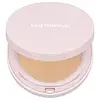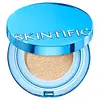What's inside
What's inside
 Key Ingredients
Key Ingredients

 Benefits
Benefits

 Concerns
Concerns

 Ingredients Side-by-side
Ingredients Side-by-side

Talc
AbrasiveTriethoxycaprylylsilane
Mica
Cosmetic ColorantPolyethylene
AbrasiveDimethicone
EmollientTridecyl Trimellitate
EmollientMagnesium Stearate
Cosmetic ColorantEthylhexyl Palmitate
EmollientSalicylic Acid
MaskingCeramide NP
Skin ConditioningNiacinamide
SmoothingC12-15 Alkyl Benzoate
AntimicrobialTocopheryl Acetate
AntioxidantUbiquinone
AntioxidantCarthamus Tinctorius Extract
EmollientHouttuynia Cordata Extract
Skin ConditioningCentella Asiatica Extract
CleansingCamellia Sinensis Leaf Extract
AntimicrobialPhenoxyethanol
Preservative1,2-Hexanediol
Skin ConditioningEthylhexylglycerin
Skin ConditioningCI 77891
Cosmetic ColorantCI 77492
Cosmetic ColorantCI 77491
Cosmetic ColorantCI 77499
Cosmetic ColorantTalc, Triethoxycaprylylsilane, Mica, Polyethylene, Dimethicone, Tridecyl Trimellitate, Magnesium Stearate, Ethylhexyl Palmitate, Salicylic Acid, Ceramide NP, Niacinamide, C12-15 Alkyl Benzoate, Tocopheryl Acetate, Ubiquinone, Carthamus Tinctorius Extract, Houttuynia Cordata Extract, Centella Asiatica Extract, Camellia Sinensis Leaf Extract, Phenoxyethanol, 1,2-Hexanediol, Ethylhexylglycerin, CI 77891, CI 77492, CI 77491, CI 77499
Water
Skin ConditioningCyclopentasiloxane
EmollientCI 77891
Cosmetic ColorantTrimethylsiloxysilicate
EmollientButylene Glycol
HumectantCyclohexasiloxane
EmollientPolyglyceryl-3 Diisostearate
EmulsifyingSynthetic Fluorphlogopite
PEG-10 Dimethicone
Skin ConditioningIsododecane
EmollientNiacinamide
SmoothingCopper Tripeptide-1
Skin ConditioningDisteardimonium Hectorite
StabilisingAstaxanthin
Skin ConditioningTocopherol
AntioxidantPEG/PPG-18/18 Dimethicone
EmulsifyingTriethoxycaprylylsilane
CI 77492
Cosmetic ColorantPolymethylsilsesquioxane
Ergothioneine
AntioxidantBetaine
HumectantPropylene Carbonate
SolventCaprylyl Glycol
EmollientCI 77491
Cosmetic ColorantGlutathione
CI 77499
Cosmetic ColorantEthylhexylglycerin
Skin ConditioningMagnesium Sulfate
Phenoxyethanol
PreservativeTribehenin
EmollientAluminum Hydroxide
EmollientTricholoma Matsutake Extract
Skin ConditioningPentylene Glycol
Skin ConditioningWater, Cyclopentasiloxane, CI 77891, Trimethylsiloxysilicate, Butylene Glycol, Cyclohexasiloxane, Polyglyceryl-3 Diisostearate, Synthetic Fluorphlogopite, PEG-10 Dimethicone, Isododecane, Niacinamide, Copper Tripeptide-1, Disteardimonium Hectorite, Astaxanthin, Tocopherol, PEG/PPG-18/18 Dimethicone, Triethoxycaprylylsilane, CI 77492, Polymethylsilsesquioxane, Ergothioneine, Betaine, Propylene Carbonate, Caprylyl Glycol, CI 77491, Glutathione, CI 77499, Ethylhexylglycerin, Magnesium Sulfate, Phenoxyethanol, Tribehenin, Aluminum Hydroxide, Tricholoma Matsutake Extract, Pentylene Glycol
Ingredients Explained
These ingredients are found in both products.
Ingredients higher up in an ingredient list are typically present in a larger amount.
Ci 77491 is also hydrated iron III oxide. It's sole purpose is to give a red/pink hue to products.
Iron III oxides are classified as inorganic chemicals for coloring.
Synthetically created Ci 77491 is considered safer than those naturally found. This is because the synthetically created version may contain less impurities. Iron oxides are generally non-toxic and non-allergenic.
Learn more about CI 77491Ci 77492 is also hydrated iron III oxide. It's sole purpose is to give a yellow hue to products.
Iron III oxides are classified as inorganic chemicals for coloring.
Synthetically created Ci 77492 is considered safer than those naturally found. This is because the synthetically created version may contain less impurities. Iron oxides are generally non-toxic and non-allergenic.
Learn more about CI 77492Ci 77499 is also hydrated iron III oxide. It is created from mixing red and black iron oxides. This helps give shades of darkness to a product.
Iron III oxides are classified as inorganic chemicals for coloring.
Ci 77891 is a white pigment from Titanium dioxide. It is naturally found in minerals such as rutile and ilmenite.
It's main function is to add a white color to cosmetics. It can also be mixed with other colors to create different shades.
Ci 77891 is commonly found in sunscreens due to its ability to block UV rays.
Learn more about CI 77891Ethylhexylglycerin (we can't pronounce this either) is commonly used as a preservative and skin softener. It is derived from glyceryl.
You might see Ethylhexylglycerin often paired with other preservatives such as phenoxyethanol. Ethylhexylglycerin has been found to increase the effectiveness of these other preservatives.
Niacinamide is a multitasking form of vitamin B3 that strengthens the skin barrier, reduces pores and dark spots, regulates oil, and improves signs of aging.
And the best part? It's gentle and well-tolerated by most skin types, including sensitive and reactive skin.
You might have heard of "niacin flush", or the reddening of skin that causes itchiness. Niacinamide has not been found to cause this.
In very rare cases, some individuals may not be able to tolerate niacinamide at all or experience an allergic reaction to it.
If you are experiencing flaking, irritation, and dryness with this ingredient, be sure to double check all your products as this ingredient can be found in all categories of skincare.
When incorporating niacinamide into your routine, look out for concentration amounts. Typically, 5% niacinamide provides benefits such as fading dark spots. However, if you have sensitive skin, it is better to begin with a smaller concentration.
When you apply niacinamide to your skin, your body converts it into nicotinamide adenine dinucleotide (NAD). NAD is an essential coenzyme that is already found in your cells as "fuel" and powers countless biological processes.
In your skin, NAD helps repair cell damage, produce new healthy cells, support collagen production, strengthen the skin barrier, and fight environmental stressors (like UV and pollution).
Our natural NAD levels start to decline with age, leading to slower skin repair, visible aging, and a weaker skin barrier. By providing your skin niacinamide, you're recharging your skin's NAD levels. This leads to stronger, healthier, and younger looking skin.
Another name for vitamin B3 is nicotinamide. This vitamin is water-soluble and our bodies don't store it. We obtain Vitamin B3 from either food or skincare. Meat, fish, wheat, yeast, and leafy greens contain vitamin B3.
The type of niacinamide used in skincare is synthetically created.
Learn more about NiacinamidePhenoxyethanol is a preservative that has germicide, antimicrobial, and aromatic properties. Studies show that phenoxyethanol can prevent microbial growth. By itself, it has a scent that is similar to that of a rose.
It's often used in formulations along with Caprylyl Glycol to preserve the shelf life of products.
Triethoxycaprylylsilane is a silicone used to bind and stabilize ingredients.
As an emulsifier, it helps prevent ingredients from separating. This can help elongate the shelf life of products.
Triethoxycaprylylsilane is often used to coat mineral sunscreens ingredients to help give a better feel. It also helps reduce oxidative stress in sunscreens.
Learn more about Triethoxycaprylylsilane